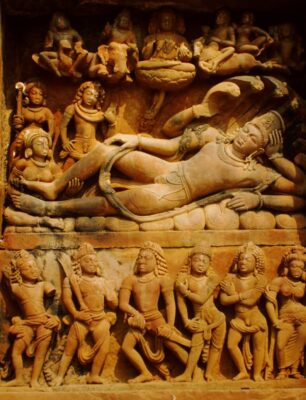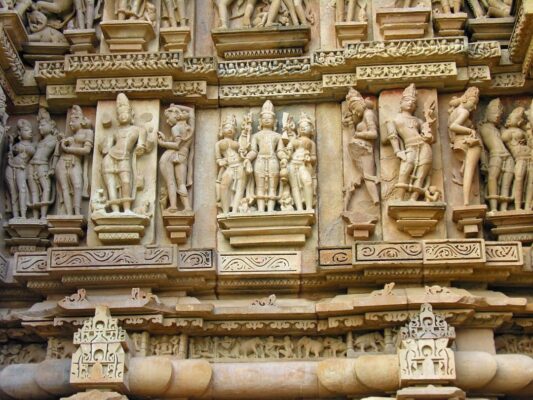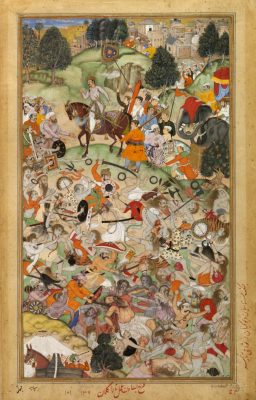Arte de la India
Subcontinente de sueños
“La India es la tierra de los sueños. La India siempre ha soñado – sobre todo con la Felicidad, que es la meta final del hombre. Y esto ha ayudado a la India a ser más creativa en la historia que cualquier otra nación. De ahí la efervescencia de mitos y leyendas, religiones y filosofías, música y danzas y los diferentes estilos de arquitectura”
Georg Wilhelm Friedrich Hegel, citado en Klosterrnaier, Klaus K A: «Survey of Hinduism». State University of New York Press. 1994

India – Vishnu from Dasavatara Temple full

India – Vishvanatha Temple Khajuraho – photo by Dennis Jarvis

Basawan – Akbar watches a Battle between two rival groups of Sannyasis at Thanesar – 1590 – VA Museum – London

Abanindranath Tagore – Bharat Mata
Imágenes: Relieve de Vishnu dormida, del Templo de Dasavatara. Siglos V-VI d.C. ·· Relieves en el Templo de Vishvanatha, Khajuraho. Siglos X-XI d.C. Fotografía de Dennis Jarvis ·· Basawan: «Akbar observa una batalla entre dos grupos rivales», c.1590 ·· Abanindranath Tagore: “Bharat Mata”, 1905. Gouache, 26.6 x 15.2 cm.
Abarcando un amplio territorio -el subcontinente indio- e intervalo temporal -cinco milenios-, el legado artístico de la India es inmenso en riqueza y diversidad, un crisol de culturas y etnias que ha dado lugar a conjuntos artísticos como los colosales monumentos del Madhya Pradesh, los refinados templos Chola, o las exquisitas miniaturas del periodo Bhopal y las pinturas de la Escuela de Bengal, además de la cultura del Valle del Río Indo y el arte de Gandhara, que por cuya importancia en el desarrollo del arte asiático se abordan en ensayos independientes.
El trasfondo habitualmente religiosos de las obras de arte de la India es testimonio de las grandes religiones presentes en su territorio: hinduismo, budismo, cristianismo, islamismo. No obstante, de acuerdo al historiador Pramod Chandra, «la tradicional clasificación del arte indio en hindú, budista y jaina es bastante inaceptable, ya que implica falsamente una diferencia esencial entre el arte producido para cada una de estas religiones» (“The Sculpture of India”, publicado por la National Gallery of Art, 1985). En la India, el estilo artístico del un tiempo concreto –consecuencia de un complejo intercambio entre pueblos- está habitualmente presente en todas las obras de arte de dicho tiempo, independientemente de la religión a la que pertenezcan.
Una interesante característica del arte de la India es su erotismo. La representación del sexo no se da en momentos y lugares puntuales, sino que se extiende prácticamente por todo el marco geográfico y temporal del arte de la India. Supone, en palabras de P. Ganesan, la existencia de “un sustrato cultural común que influyó en las sectas religiosas de toda la India” (“Indian Temples and the Erotic Sculptured Art”, International Academic Forum, 2016). No se trata tampoco de imágenes ocultas o semiescondidas, sino que ocupan lugares preferentes en algunos de los más importantes templos de la India, especialmente en los templos y monumentos Khajuraho en el Madhya Pradesh.
Desde la independencia de la India en 1947, y ya entrado el siglo XXI, la India sigue siendo un importante centro de producción artística, donde artistas de diverso origen han incorporado influencias occidentales (postmodernismo, expresionismo abstracto) al milenario arte de la India, ocupándose también de los problemas de la sociedad de la India contemporánea.
G. Fernandez · theartwolf.com
Indian Art
Subcontinent of Dreams
“India is the land of dreams. India had always dreamt – more of the Bliss that is man’s final goal. And this has helped India to be more creative in history than any other nation. Hence the effervescence of myths and legends, religious and philosophies, music, and dances and the different styles of architecture”
Georg Wilhelm Friedrich Hegel, quoted in Klosterrnaier, Klaus K A: “Survey of Hinduism”. State University of New York Press. 1994

India – Vishnu from Dasavatara Temple full

India – Vishvanatha Temple Khajuraho – photo by Dennis Jarvis

Basawan – Akbar watches a Battle between two rival groups of Sannyasis at Thanesar – 1590 – VA Museum – London

Abanindranath Tagore – Bharat Mata
Images: Relief of Vishnu sleeping, from the Dasavatara Temple. 5th-6th century AD ·· Reliefs in the Vishvanatha Temple, Khajuraho. 10th-11th centuries AD. Photograph by Dennis Jarvis ·· Basawan: «Akbar watches a Battle between two rival groups of Sannyasis at Thanesar«, c.1590 ·· Abanindranath Tagore: «Bharat Mata», 1905. Gouache, 26.6 x 15.2 cm.
Spanning a vast territory -the Indian subcontinent- and time span -five millennia- India’s artistic legacy is immense in richness and diversity, a melting pot of cultures and ethnicities that has given rise to artistic ensembles such as the colossal monuments of Madhya Pradesh, the refined Chola temples, or the exquisite miniatures of the Bhopal period and the paintings of the Bengal School, as well as the Indus Valley Civilization and the Art of Gandhara, whose importance in the development of Asian art is dealt with in separate essays.
The usually religious background of India’s works of art is testimony to the great religions present in its territory: Hinduism, Buddhism, Christianity, Islam. However, according to historian Pramod Chandra, «the communal classification of Indian art into Hindu, Buddhist, and Jaina is quite unacceptable, for it falsely implies an essential difference between the art produced for each of these religions» («The Sculpture of India», published by the National Gallery of Art, 1985). In India, the artistic style of a particular time -the result of a complex exchange between peoples and cultures- is usually present in all works of art of that time, irrespective of the religion to which they belong.
An interesting characteristic of Indian art is its eroticism. The representation of sex does not occur at specific times and places, but extends practically throughout the entire geographical and temporal framework of Indian art. It implies, in the words of P. Ganesan, the existence of “a common cultural substratum which influenced religious sects all over India” (“Indian Temples and the Erotic Sculptured Art”, International Academic Forum, 2016). These are not hidden or semi-hidden images either, but occupy pride of place in some of the most important temples in India, especially in the Khajuraho temples and monuments in Madhya Pradesh.
Since India’s independence in 1947, and well into the 21st century, India continues to be an important centre of artistic production, where artists of diverse backgrounds have incorporated Western influences (postmodernism, abstract expressionism) into India’s age-old art, while also addressing the problems of contemporary Indian society.
G. Fernandez · theartwolf.com



